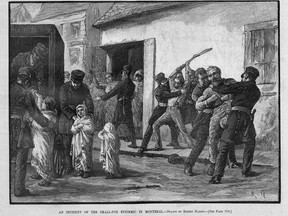In the context of COVID-19, which reminded the world of the power of a novel virus to bring illness and death, it is important to remember what was accomplished on Dec. 9, 1979.
Published Dec 09, 2023 • Last updated 4 hours ago • 3 minute read
 This sketch, called ‘Incident of the Smallpox Epidemic, Montreal,’ by Robert Harris, shows the violence with which the sanitary police removed smallpox patients from the public to quarantine them. The illustration was first published in Harper’s Weekly, on Nov. 28, 1885. Photo by Robert Harris
This sketch, called ‘Incident of the Smallpox Epidemic, Montreal,’ by Robert Harris, shows the violence with which the sanitary police removed smallpox patients from the public to quarantine them. The illustration was first published in Harper’s Weekly, on Nov. 28, 1885. Photo by Robert Harris
On Dec. 9, 1979, the Global Commission for the Certification of Smallpox Eradication declared its job complete. This marked the end of a scourge that lasted thousands of years and killed more people than all the wars in recorded history.
In the 20th century alone, smallpox killed some 300 million, or more than double the death toll of the wars of that century. Smallpox (or a closely related virus) had been maiming and killing humans for thousands of years. It likely killed the Egyptian Pharaoh Ramses V. In 1967, when the World Health Organization (WHO) started a serious eradication effort, there were more than 10 million smallpox cases and two million deaths spread across 43 countries. Nevertheless, within 12 years the disease was eradicated. This is perhaps humanity’s largest triumph.
Advertisement 2
This advertisement has not loaded yet, but your article continues below.
THIS CONTENT IS RESERVED FOR SUBSCRIBERS ONLY
Subscribe now to read the latest news in your city and across Canada.
Exclusive articles from Elizabeth Payne, David Pugliese, Andrew Duffy, Bruce Deachman and others. Plus, food reviews and event listings in the weekly newsletter, Ottawa, Out of Office.Unlimited online access to Ottawa Citizen and 15 news sites with one account.Ottawa Citizen ePaper, an electronic replica of the print edition to view on any device, share and comment on.Daily puzzles, including the New York Times Crossword.Support local journalism.
SUBSCRIBE TO UNLOCK MORE ARTICLES
Subscribe now to read the latest news in your city and across Canada.
Exclusive articles from Elizabeth Payne, David Pugliese, Andrew Duffy, Bruce Deachman and others. Plus, food reviews and event listings in the weekly newsletter, Ottawa, Out of Office.Unlimited online access to Ottawa Citizen and 15 news sites with one account.Ottawa Citizen ePaper, an electronic replica of the print edition to view on any device, share and comment on.Daily puzzles, including the New York Times Crossword.Support local journalism.
REGISTER TO UNLOCK MORE ARTICLES
Create an account or sign in to continue with your reading experience.
Access articles from across Canada with one account.Share your thoughts and join the conversation in the comments.Enjoy additional articles per month.Get email updates from your favourite authors.
Article content
Article content
In calling this “humanity’s largest triumph,” we are picking our words carefully. The eradication of smallpox was arguably the first truly humanity-wide achievement. Humankind was only able to eradicate smallpox because governments, vaccine researchers and producers, health-care workers and regular people from across the globe came together.
That this happened during the Cold War makes it even more impressive. It is an achievement that belongs to all human beings, of every gender, nationality and ethnicity. The eradication of smallpox highlights the truly amazing things that humans can achieve together.
However, this monumental success has been largely forgotten. It is valuable to have national days that attempt to raise the ambitions of Canadians and remind us of what we can achieve when we collaborate globally. It is especially fitting to choose smallpox eradication for a commemorative day in Canada, as not only was eradication humanity’s largest shared success but Canadians played key roles in smallpox vaccine development and production.
For example, Connaught Laboratories, part of the University of Toronto until 1972, helped establish an international freeze-dried smallpox vaccine standard. Connaught also produced millions of doses of freeze-dried vaccine for the eradication campaign, provided through the Canadian government, and served as the international vaccine reference lab for the western hemisphere. In the latter role, Connaught scientists, most notably Dr. Paul Fenje and Dr. Robert J. Wilson, worked with smallpox vaccine producers in Latin America to improve vaccine quality and effectiveness.
Advertisement 3
This advertisement has not loaded yet, but your article continues below.
Article content
Inspired by the success of the smallpox eradication initiative, in 1988 the WHO, in partnership with Rotary International and many governments, Canada included in a major way, set its sights on eradicating poliomyelitis, otherwise known as “the crippler.” Like smallpox virus, poliovirus only infects humans and could thus be eradicated if all humans were immunized.
The challenge proved more complex with polio than had been the case for smallpox.
While the smallpox eradication program took a little over a decade to complete, progress has been slower with polio eradication over the past 35 years, although confirmed global cases have dropped from 300,000 per year in 1988, to just 12 as this is written. As was true for smallpox eradication, the motivation for the polio eradication program has been the desire to reduce deaths, and especially polio’s crippling effects in children, and to ultimately eliminate the need for polio immunization and its ongoing expense, particularly in the developing world.
In the wake of the COVID-19 pandemic, which reminded the world of the power of a novel virus to bring, without warning, illness and death, as well as transformative change to the globe, it is important to look back to what was accomplished on Dec. 9, 1979. This date, which marks the unprecedented heroic human effort to finally eliminate the centuries-long scourge of “the speckled monster” of smallpox, should thus be formally recognized annually as “Smallpox Eradication Day.”
Ryan Briggs is an Associate Professor at the University of Guelph. Christopher J. Rutty, PhD., is a professional medical and public health historian and an Adjunct Professor at the Dalla Lana School of Public Health, University of Toronto.
Related Stories

Pellerin: Yes, Ottawa’s libraries need security — but that’s not enough

Opinion: Food bank demand grows — while we continue to throw out food
Article content
>>> Read full article>>>
Copyright for syndicated content belongs to the linked Source : OttawaCitizen – https://ottawacitizen.com/opinion/briggs-and-rutty-why-we-should-declare-a-formal-smallpox-eradication-day














![[News] Japan Develops 10nm Nanoimprint Technology, with Potential to Tackle EUV Bottleneck – TrendForce](https://earth-news.info/wp-content/uploads/2025/12/329851-news-japan-develops-10nm-nanoimprint-technology-with-potential-to-tackle-euv-bottleneck-trendforce-360x180.jpg)
















